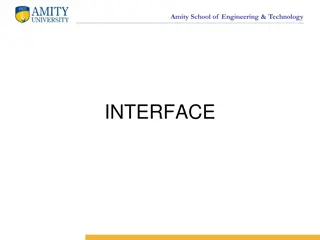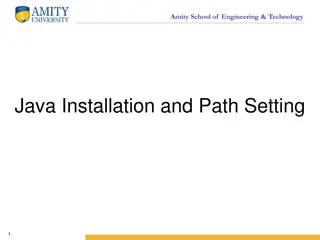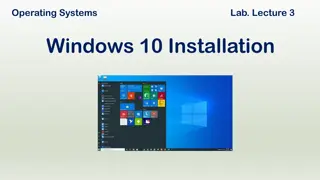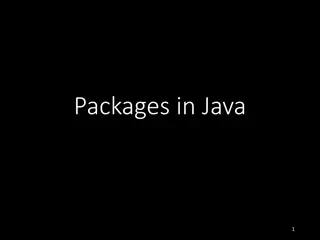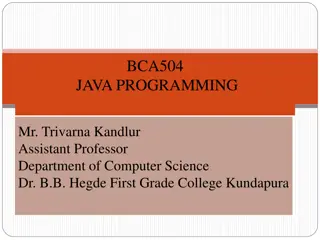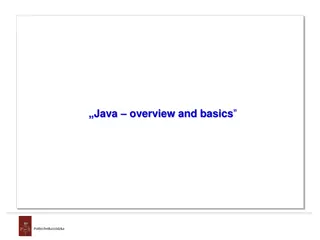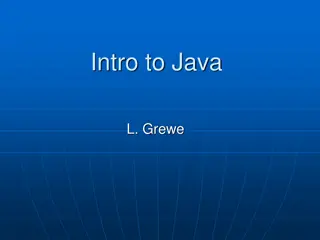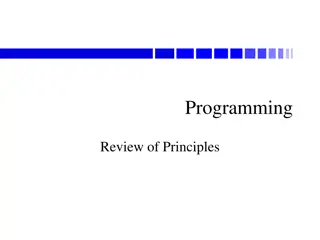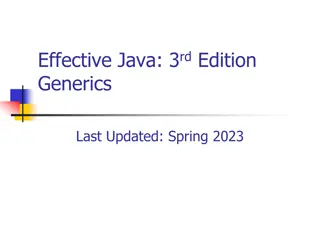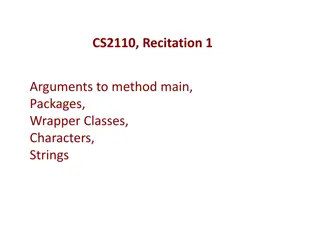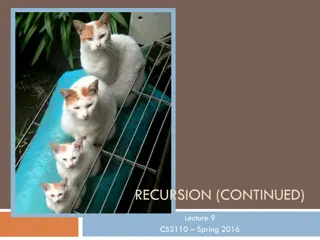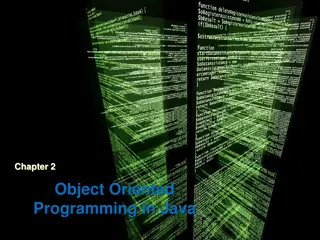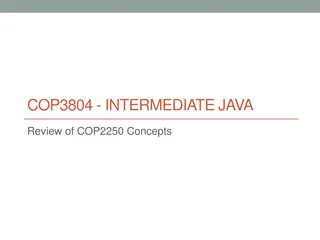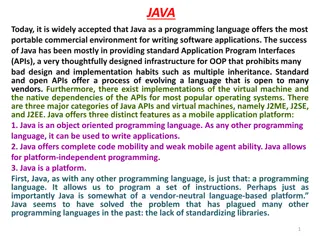Java Programming: History, Installation, and Basics" (67 characters)
Java is a popular statically typed object-oriented programming language with a rich history. This overview covers the origins of Java, how to install it, an introduction to IDEs, compiling and running programs, Java naming conventions, and more. Dive into the fundamental concepts of Java programming and discover why it is widely used across various domains. (305 characters)
Download Presentation

Please find below an Image/Link to download the presentation.
The content on the website is provided AS IS for your information and personal use only. It may not be sold, licensed, or shared on other websites without obtaining consent from the author.If you encounter any issues during the download, it is possible that the publisher has removed the file from their server.
You are allowed to download the files provided on this website for personal or commercial use, subject to the condition that they are used lawfully. All files are the property of their respective owners.
The content on the website is provided AS IS for your information and personal use only. It may not be sold, licensed, or shared on other websites without obtaining consent from the author.
E N D
Presentation Transcript
Java vs Java vs Python Python runestone.academy/ns/books/published/java4python/
Why Why should should you you know know something something about about Java? Java? Java is an example of a statically typed object oriented language (like C and C++) opposed to Python s being dynamically typed One of the most widespread used programming languages Used in other courses at the Department of Computer Science
Java Java history history Java 1.0 released 1995 by Sun Microsystems (acquired by Oracle 2010) PyPy is adopting the same ideas to Python (Just-in-Time compilation) Write Once, Run Anywhere 1999 improved performance by the Java HotSpot Performance Engine Current version Java 20 (released March 2023) Java compiler generates Java bytecode that is executed on a Java virtual machine (JVM)
Installing Installing Java Java To compile Java programs into bytecode you need a compiler, e.g. from Java SE Development Kit (JDK): www.oracle.com/java/technologies/downloads/ (you might need to add the JDK directory to your PATH, e.g. C:\Program Files\Java\jdk-18.0.1.1\bin) To only run compiled Java programs: java.com/download (If you use JDK, you should not download this)
Java IDE Java IDE Many available, some popular: Visual Studie Code, IntelliJ IDEA, Eclipse, and NetBeans An IDE for beginners: BlueJ
Compiling Compiling and and running running a Java program a Java program HelloWorld.java public class HelloWorld { public static void main( String[] args ) { System.out.println( "Hello World!" ); } } HelloWorld.java Java compiler (javac) HelloWorld.class Java Virtual Machine (java) execution
Java : Java : main name.java must be equal to the public class name A class can only be excuted using javaname (without .class) if the class has a class method main with signature public static void main(String[] args) (main is inherited from C and C++ sharing a lot of syntax with Java) Java convention is that class names should use CamelCase PrintArguments.java public class PrintArguments { public static void main( String[] args ) { for (int i=0; i<args.length; i++) System.out.println( args[i] ); } } shell > java PrintArguments x y z | x | y | z
a static method in a class is a class method (exists without creating objects) method name type of return value (void = no return value) class name containing main must have same name as file there can be several classes in a file but only one class should be public and have same name as file type of argument, array of String values PrintArguments.java public class PrintArguments { public static void main( String[] args ) { for (int i=0; i<args.length; i++) System.out.println( args[i] ); } } the main method must be public to be visible outside class name of argument For-loop equivalent to int i=0 while (i<args.length) { code i++; } declare new int variable locally inside for-loop the print statement is found in the System class java arrays are indexed from 0 to args.length 1 and the length of an array object is fixed once created i += 1
Argument list also exists in Python... Argument list also exists in Python... PrintArguments.py import sys print(sys.argv) shell > python PrintArguments.py a b 42 | ['PrintArguments.py', 'a', 'b', '42']
Primitive.java /** * A Java docstring to be processed using 'javadoc' */ // comment until end-of-line public class Primitive { public static void main( String[] args ) { int x; // type of variable must be declared before used x = 1; // remember ';' after each statement int y=2; // indentation does not matter int a=3, b=4; // multiple declarations and initialization System.out.println(x + y + a + b); int[] v={1, 2, 42, 3}; // array of four int System.out.println(v[2]); // prints 42, arrays 0-indexed /* multi-line comment that continues until here */ v = new int[3]; // new array of size three, containing zeros System.out.println(v[2]); // prints 0 if (x == y) { // if-syntax '(' and ')' mandatory a = 1; b = 2; } else { // use '{' and '}' to create block of statements a = 4; b = 3; // two statements on one line } }}
Why Why state Just enforcing a different programming style (also C and C++) Helps users to avoid mixing up values of different types (Some) type errors can be caught at compile time More efficient code execution state types types Python Python works works without without... ... TypeError.java public class TypeError { public static void main( String[] args ) { int x = 3; String y = "abc"; System.out.println(x / y); } } type_error.py x = 3 y = 'abc' print('program running...') print(x / y) shell > javac TypeError.java | javac TypeError.java | TypeError.java:5: error: bad operand types for binary operator '/' | System.out.println(x / y); | | first type: int | second type: String | 1 error Python shell | program running... ... | ----> 4 print(x / y) | TypeError: unsupported operand type(s) for /: 'int' and 'str' ^
Basic Java types Basic Java types BigIntegerTest.java import java.math.*; // import everything // import java.math.BigInteger; // alternativ public class BigIntegerTest { public static void main( String[] args ) { BigInteger x = new BigInteger("2"); while (true) { // BigIntegers are immutable x = x.multiply(x); // java.math.BigInteger.toString() System.out.println(x); } } } Type boolean byte char short int long float double class BigInteger class String Values true or false 8 bit integer character (16-bit UTF) 16 bit integer 32 bit integer 64 bit integer shell | 4 | 16 | 256 | 65536 | 4294967296 | 18446744073709551616 | 340282366920938463463374607431768211456 | ... 32 bit floating bout 64 bit floating point arbitrary precision integers strings
ConcatenateArrayLists.java import java.util.*; // java.util contains ArrayList Java arrays Java arrays public class ConcatenateArrayList { public static void main( String[] args ) { // ArrayList is a generic container ArrayList<String> a = new ArrayList<String>(); ArrayList<String> b = new ArrayList<String>(); ArrayList<String> c = new ArrayList<String>(); a.add("A1"); // in Python .append a.add("A2"); b.add("B1"); c.addAll(a); // in Python .extend c.addAll(b); for (String e : c) { // foreach over iterator System.out.println(e); } } } The size of a builtin Java array can not be modified when first created. If you need a bigger array you have to instantiate a new array. Or better use a standard collection class like ArrayList ArrayList is a generic class (type of content is given by <element type>; generics available since Java 5, 2004) The for-each loop was introduced in Java 5 shell | A1 | A2 | B1
Tired Tired of of writing writing all all these these types... types... In Java 7 (2011) the diamond operator <> was introduced for type inference for generic instance creation to reduce verbosity In Java 10 (2018) the var keyword was introduced to type infer variables ArrayListTest.java import java.util.*; // java.util contains ArrayList public class ArrayListTest { public static void main( String[] args ) { // ArrayList is a generic container ArrayList<String> a = new ArrayList<String>(); // Full types List<String> b = new ArrayList<String>(); // ArrayList is subclass of class List ArrayList<String> c = new ArrayList<>(); // <> uses type inference List<String> d = new ArrayList<>(); // <> and ArrayList subclass of List var e = new ArrayList<String>(); // use var to infer type of variable var v = Math.floor(1.5); // not obvious what type v is (double) }}
Functions.java public class Functions { private static int f(int x) { return x * x; } private static int f(int x, int y) { return x * y; } private static String f(String a, String b) { return a + b; // string concatenation } Function Function arguments arguments Must declare the number of arguments and their types, and the return type The argument types are part of the signature of the function Several functions can have the same name, but different type signatures public static void main( String[] args ) { System.out.println(f(7)); System.out.println(f(3, 4)); System.out.println(f("abc", "def")); } functions.py } def f(x, y=None): if y == None: y = x if type(x) is int: return x * y else: return x + y print(f(7), f(3, 4), f('abc', 'def')) shell | 49 | 12 | abcdef Python keyword arguments, * and ** do not exist in Java
AClass.java class Rectangle { private int width, height; // declare attributes // constructor, class name, no return type public Rectangle(int width, int height) { this.width = width; this.height = height; } public Rectangle(int side) { width = side; // same as this.width = side height = side; } public int area() { return width * height; } } public class AClass { public static void main( String[] args ) { Rectangle r = new Rectangle(6, 7); System.out.println(r.area()); } } Class Class Constructor = method with name equal to class name (no return type) this = referes to current object (Python self ) Use private / public on attributes / methods to give access outside class Use newname(arguments) to create new objects There can be multiple constructors, but with distinct type signatures shell | 42
Inheritance.java class BasicRectangle { // protected allows subclass to access attributes protected int width, height; public BasicRectangle(int width, int height) { this.width = width; this.height = height; } } class Rectangle extends BasicRectangle { public Rectangle(int width, int height) { // call constructor of super class super(width, height); } public int area() { return width * height; } } public class Inheritance { public static void main( String[] args ) { Rectangle r = new Rectangle(6, 7); System.out.println(r.area()); } } Inheritance Inheritance Java supports single inheritance using extends Attributes and methods that should be accessible in a subclass must be declared protected (or public) Constructors are not inherited but can be called using super shell | 42
Generic Generic class class GenericPair.java class Pair<element> { private element x, y; public Pair(element x, element y) { this.x = x; this.y = y; } element first() { return x; } element second() { return y; } } public class GenericPair { public static void main( String[] args ) { var p = new Pair<Integer>(6, 7); System.out.println(p.first() * p.second()); } } shell | 42 Class that is parameterized by one or more types (comma separated) Primitive types cannot be type parameters Instead use wrappers, like Integer for int
Interface Interface Java does not support multiple inheritance like Python But a class can implement an arbitrary number of interfaces An interface specifices a set of attributes and methods a class must have The type of a variable can be an interface, and the variable can hold any object where the class is stated to implement the interface RectangleInterface.java interface Shape { public int area(); // method declaration } class Rectangle implements Shape { private int width, height; // constructor, class name, no return type public Rectangle(int width, int height) { this.width = width; this.height = height; } public int area() { return width * height; } } public class RectangleInterface { public static void main( String[] args ) { Shape r = new Rectangle(6, 7); System.out.println(r.area()); } }
AbstractRectangle.java Abstract Abstract classes classes abstract class Shape { abstract public int circumference(); abstract public int area(); public double fatness() { // convert int from area() to double before / return (double)area() / circumference(); } } class Rectangle extends Shape { private int width, height; // constructor, class name, no return type public Rectangle(int width, int height) { this.width = width; this.height = height; } public int area() { return width * height; } public int circumference() { return 2 * (width + height); } } public class AbstractRectangle { public static void main( String[] args ) { Shape r = new Rectangle(6, 7); System.out.println(r.fatness()); } } Abstract class = class that cannot be instantiated, labeled abstract Abstract method = method declared without definition, labeled abstract, must be in abstract class An abstract class can be extended to a non-abstract class by providing the missing method definitions
Default Default methods methods in interfaces in interfaces DefaultInterface.java interface Shape { public int circumference(); public int area(); default public double fatness() { // convert int from area() to double before / return (double)area() / circumference(); } } class Rectangle implements Shape { private int width, height; // constructor, class name, no return type public Rectangle(int width, int height) { this.width = width; this.height = height; } public int area() { return width * height; } public int circumference() { return 2 * (width + height); } } public class DefaultRectangle { public static void main( String[] args ) { Shape r = new Rectangle(6, 7); System.out.println(r.fatness()); } } Before Java 8 all methods in an interface were abstract (no definition) Since Java 8 interfaces can have default methods with definition The distinction between abstract classes and interfaces gets blurred a class can only extend one abstract class a class can implement more interfaces multiple inheritance is possible in Java
Multiple Multiple Inheritance Inheritance MultipleInheritance.java interface A { default public void sayA() { System.out.println("say A"); } default public void sayHi() { System.out.println("A say's Hi"); } } interface B { default public void sayB() { System.out.println("say B"); } default public void sayHi() { System.out.println("B say's Hi"); } } class C implements A, B { @Override // (optional) requests compiler to // check if sayHi exists in supertype public void sayHi() { System.out.println("C say's Hi"); (new A(){}).sayHi(); // instantiate an anonymous class } public void test() { sayA(); sayB(); sayHi(); } } public class MultipleInheritance { public static void main( String[] args ) { new C().test(); } } Class C implements both interfaces A and B Inherits default methods sayA and sayB Cannot inherit sayHi, since in both A and B. Must be overriden in C Can use @override to enforce compiler to check if method exists in super class new A(){} creates an instance of an anonymous class (extending or implementing A) Shell output say A say B C say's Hi A say's Hi
Lambda expression Lambda expression Lambda expressions are possible since Java 8 Syntax : argument -> expression LambdaPrinting.java import java.util.*; // ArrayList public class LambdaPrinting { public static void main(String[] args) { var elements = new ArrayList<Integer>(); for (int i = 1; i <= 3; i++) elements.add(i); elements.forEach(e -> System.out.println(e)); }; } LambdaPrinting.java 1 2 3



